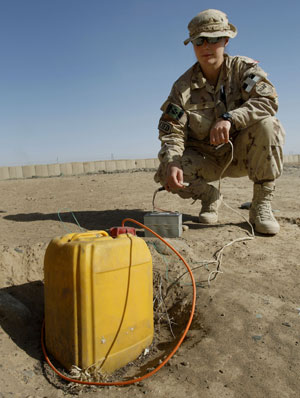 |
| Lt. Caroline Pollock sets up an IED fortraining purposes at Camp Hero in Kandahar, southern Afghanistan.(AP Photo/Kirsty Wigglesworth) |
Modern-day booby traps, home-made destruction, indiscriminateweapons-in-disguise. IEDs – Improvised Explosive Devices– are the weapon-of-choice for Taliban insurgents and posethe greatest threat to allied forces in Afghanistan.
Interest in roadside bombs and the soldiers who locate anddisarm them has been heightened recently, thanks to The HurtLocker, winner of this year's Best Picture Oscar. The filmfollows staff sergeant and bomb technician William James (JeremyRenner) as he and his team search out IEDs in Iraq.
But how accurate is the movie portrayal of this intense andcrucially important job?
“There are similarities,” admits Lieutenant CarolinePollock. The 27-year-old Dalhousie engineering alum is an ExplosiveOrdinance Disposal (EOD) Troop Commander with the Canadian Forcesin Afghanistan.
“(It's the) same bomb suit, work is done in a team, robotsare used for investigation, render safe and exploitation of IEDswhere possible (and) teams go out with a Quick ReactionForce,” she explains.
There are, however, key differences between film and reality.“I have not met any EOD operators that are cross-trained assnipers,” she quips, referring to a scene from the film whenSgt. James’ team is involved in a shoot-out while searchingfor IEDs alone, another no no. “In reality, EOD teams do notdrive around on their own.”
Mentoring
On this particular tour, Lt. Pollock leads a troop of 20soldiers, broken down into teams scattered in the area ofoperations within Kandahar Province. One of these teams isresponsible for conducting and co-ordinating mentorship with theAfghan National Army’s EOD troop at Camp HERO near KandaharAirfield.
This is an important task in order to ensure the Afghans arecapable of operating on their own once the Canadian Forces completetheir combat role in 2011.
Detecting IEDs, she explains, is usually done visually whileconducting a “vulnerable point search” – such asa culvert, bridge, intersection, etc. Soldiers look for combatindicators – signs that an IED is placed in a certain area,and the employment of a mine detector helps to delineate where anIED might be placed.
The work of the Canadian Forces and Afghan soldiers helpsprotect civilians as well. Ground forces discover or confirm an IED– sometimes based on a tip from a local national – andprovide security while the team works to disarm the bomb. Dependingon the type of IED, this can protect locals from accidentallysetting off the device.
Indiscriminate
“In some regions, the local Taliban are less concernedabout collateral damage, meaning they place IEDs withoutdiscriminating against the target,” says Lt. Pollock.“The insurgents have targeted heavily populated areas, likeKandahar City on March 13, where over 30 casualties occurred,mostly civilians … In other areas, efforts are made toensure that specific types of IEDs are employed to effectivelytarget (soldiers). This was evident in the December 30 incidentwhere we lost five Canadians. including one civilianreporter.”
Lt. Pollock says dealing with these stresses takes a strong,type- A personality, an intelligent and confident team player. Inher down time, she tries to stay in shape by working out at the gymand running road races. She also enjoys reading and knitting.
After graduating from industrial engineering in 2007, Lt.Pollock used her Dalhousie degree to become an engineering officerin the Canadian Forces and took an interest in EOD disposal. Hercounter IED sub-unit is responsible for deploying teams to supportbattle groups and training forces in the skills required to counterthe threat of IEDs.
